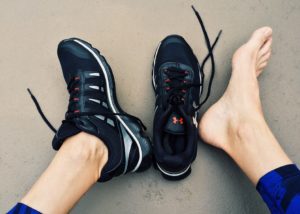By Aaron Boike, B.S. Kinesiology, ACE Certified Personal Trainer and Health Coach
For years we’re been taught that when we are dealing with heel or foot pain we go to the shoe store, the foot doctor, or a combination of the two to get fitted with custom orthotics or hyper-supportive shoes that help to “correct” our gait. But recent research is changing the way we look at foot and heel pain. There are two main types of lower leg and foot injuries we’re referring to in this post, Achilles Tendonitis (or tendonosis, as it’s now referred to) and Plantar Fasciitis , but there are a myriad of others that, in theory, may be responsive to similar treatment.
What is Achilles Tendonosis?
Formerly referred to simply as “achilles tendonitis” referring to an inflammation of the achilles tendon which connects the calf muscles to the plantar facia on the bottom of the foot. Research has led to the name change for longer term pain in the achilles, as it appears that this injury comes not from inflammation, but from degeneration and a disorganized structure in the tendon, which leads to small tears in the achilles. This leads to pain and weakness. This injury is common in runners and athletes.
What is Plantar Fasciitis?
This common condition is simply referring to inflammation of the plantar facia on the bottom of the foot. This band of facia runs from the heel bone to your toes. Pain often begins in the heel and/or arch. It is estimated that 10% of the population will deal with Plantars Fasciitis in their lifetime.
What research is showing…
The eccentric phase of any exercise is the “down phase” where the body is working against the resistance of gravity. An example would be on a bench press – when you lower the bar towards your chest, that is the eccentric phase of the exercise. Eccentrics overload the muscle and cause micro tears which leads to the muscle fibers to be repaired stronger and thicker than they were previously. This process is often referred to as hypertrophy. Research suggests that eccentrics may have a “re-organizing” effect on the soft tissue is tendons and fascia, as well.
Research on eccentric focused exercises for the lower leg has shown great promise in treating achilles tendon pain. In an article published in The American Journal of Sports Medicine, a group of 15 recreational athletes with symptoms of achilles tendonosis were treated with a 12-week protocol of heavy eccentric training, while 15 were treated with conventional treatments for achilles tendonosis (rest, NSAIDs, orthotics, physical therapy). Remarkably the 15 recreational athletes who were on the eccentric training protocol all returned to their pre-injury levels of training, while the 15 who were conventionally treated were unsuccessful and all ended up opting for surgery to repair their achilles tendon (Alfredson, et. all, 1998).
A 2014 article published in the Scandinavian Journal of Medicine and Sports Science showed similar results for Plantar Fasciitis, with a group of 48, half of whom participated in plantar specific stretching, and half of whom participated in high load strength training. After three months, the participants who participated in the strength training protocol, consisting of unilateral heel raises w/ a slow and controlled decent done in a unilateral fashion (similar to the eccentric heel drops shown below), had dramatic improvement in symptoms, while the stretching group noticed minimal improvement. (Rathleff, et al, 2014).
While the two injuries are not one in the same, they seems to respond to a program of eccentric strengthening program focused on the calf and the achilles. These exercises are easy to implement into your routine, and can often be done at home. Here are a few key exercises that can help you build strength through your lower legs and ward off Achilles Tendonitis and Plantar Fasciitis. As always, check with your doctor or physical therapist if you’re currently dealing with an injury before adopting any protocol based on the advice below.
The Eccentric Heel Drop
This is the primary exercise utilized in both studies listed above. For the plantar fasciitis trial, it was done barefoot with a rolled up towel under the toes for further activation of the tissues of the foot. The key with this exercise is a slow and controlled eccentric (down) phase.
Seated Calf Raise Machine
Most gyms have this machine available. This exercise can also be performed with a chair or bench, a step or riser, and some weights placed on the thighs. Keep a slow and controlled form on the descent.
Sources:
Alfredson, H., Pietilä, T., Jonsson, P., & Lorentzon, R. (n.d.). Heavy-Load Eccentric Calf Muscle Training For the Treatment of Chronic Achilles Tendinosis – Håkan Alfredson, Tom Pietilä, Per Jonsson, Ronny Lorentzon, 1998. Retrieved from https://journals.sagepub.com/doi/abs/10.1177/03635465980260030301.
Goom, T., & Goom, T. (2019, March 25). Plantar fasciitis – important new research by Michael Rathleff. Retrieved from https://www.running-physio.com/pf-new-research/
